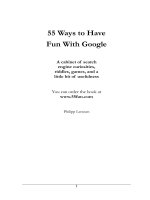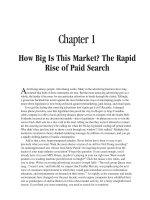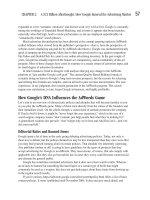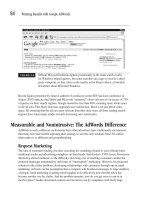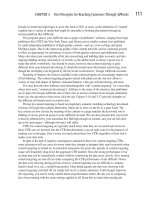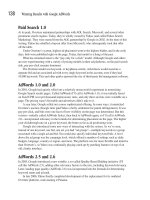940 developing with google+
Bạn đang xem bản rút gọn của tài liệu. Xem và tải ngay bản đầy đủ của tài liệu tại đây (11.65 MB, 104 trang )
www.it-ebooks.info
www.it-ebooks.info
Developing with Google+
Jennifer Murphy
Beijing • Cambridge • Farnham • Köln • Sebastopol • Tokyo
www.it-ebooks.info
Developing with Google+
by Jennifer Murphy
Copyright © 2012 Jennifer Murphy. All rights reserved.
Printed in the United States of America.
Published by O’Reilly Media, Inc., 1005 Gravenstein Highway North, Sebastopol, CA 95472.
O’Reilly books may be purchased for educational, business, or sales promotional use. Online editions
are also available for most titles (). For more information, contact our
corporate/institutional sales department: 800-998-9938 or
Editors: Mike Loukides and Meghan Blanchette
Production Editor: Holly Bauer
Proofreader: Christie Rears
Cover Designer: Randy Comer
Interior Designer: David Futato
Illustrator: Rebecca Demarest
Revision History for the First Edition:
2012-09-07
First release
See for release details.
Nutshell Handbook, the Nutshell Handbook logo, and the O’Reilly logo are registered trademarks of
O’Reilly Media, Inc. Developing with Google+, the image of a pardalote, and related trade dress are
trademarks of O’Reilly Media, Inc.
Many of the designations used by manufacturers and sellers to distinguish their products are claimed as
trademarks. Where those designations appear in this book, and O’Reilly Media, Inc., was aware of a
trademark claim, the designations have been printed in caps or initial caps.
While every precaution has been taken in the preparation of this book, the publisher and authors assume
no responsibility for errors or omissions, or for damages resulting from the use of the information contained herein.
ISBN: 978-1-449-31226-8
[LSI]
1347046338
www.it-ebooks.info
Table of Contents
Preface . . . . . . . . . . . . . . . . . . . . . . . . . . . . . . . . . . . . . . . . . . . . . . . . . . . . . . . . . . . . . . . . . . . . . . v
1. Introduction . . . . . . . . . . . . . . . . . . . . . . . . . . . . . . . . . . . . . . . . . . . . . . . . . . . . . . . . . . . 1
Things You May Recognize
Things That May Be New to You
Explore the API
1
2
3
2. Social Plugins . . . . . . . . . . . . . . . . . . . . . . . . . . . . . . . . . . . . . . . . . . . . . . . . . . . . . . . . . . 7
The +1 Button
Adding the +1 Button
Customizing the +1 Button
Customizing Your Snippet
Leveraging the Callback
Special Considerations for AJAX Applications
Troubleshooting the +1 Button
The Badge
Adding the Badge
Performance Tuning Social Plugins
Asynchronous Loading
Explicit Rendering
Delayed Rendering
Keeping Up to Date
7
10
13
14
16
17
19
21
22
26
26
26
27
29
3. Public Data APIs . . . . . . . . . . . . . . . . . . . . . . . . . . . . . . . . . . . . . . . . . . . . . . . . . . . . . . . 31
Integrating Google+ Comments
Experiment with the APIs
Client Libraries
Registering Your Application
Time to Code
Comments Integration in Action
What’s Next?
31
31
36
36
37
39
40
iii
www.it-ebooks.info
4. OAuth-Enabled APIs . . . . . . . . . . . . . . . . . . . . . . . . . . . . . . . . . . . . . . . . . . . . . . . . . . . . 41
New Application: Baking Disasters 2.0
Authentication Using Google+
OAuth 2.0
Accounts and API Keys
A Little More About OAuth 2.0
Starter Projects
Bringing it Together
Locking Stuff Down
A Preview of the Sign-in Button
Making Baking Disasters Social
Import Disasters from Google+
A Preview of the History API
Best Practices
41
42
43
44
46
46
49
54
57
58
58
62
64
5. Collaborative Baking with Hangout Apps . . . . . . . . . . . . . . . . . . . . . . . . . . . . . . . . . . 65
Potluck Party Planner
Architecture of a Hangout App
Hosting a Hangout App
Starting with a Starter Project
Convert the Starter Project to PHP
Run the Starter Project
Collaborative Planning
Recipe and Ingredient REST APIs
Hangout App Interface
Hangout App Startup
Shared State and HTML Manipulations
Add Reminder Sharing
Media APIs
Other Hangout APIs
Publishing
65
66
66
68
68
69
72
72
75
77
78
81
84
86
86
6. Wrapping Up the Baked Goods . . . . . . . . . . . . . . . . . . . . . . . . . . . . . . . . . . . . . . . . . . . 91
iv | Table of Contents
www.it-ebooks.info
Preface
Conventions Used in This Book
The following typographical conventions are used in this book:
Italic
Indicates new terms, URLs, email addresses, filenames, and file extensions.
Constant width
Used for program listings, as well as within paragraphs to refer to program elements
such as variable or function names, databases, data types, environment variables,
statements, and keywords.
Constant width bold
Shows commands or other text that should be typed literally by the user.
Constant width italic
Shows text that should be replaced with user-supplied values or by values determined by context.
This icon signifies a tip, suggestion, or general note.
This icon indicates a warning or caution.
Using Code Examples
This book is here to help you get your job done. In general, you may use the code in
this book in your programs and documentation. You do not need to contact us for
permission unless you’re reproducing a significant portion of the code. For example,
writing a program that uses several chunks of code from this book does not require
permission. Selling or distributing a CD-ROM of examples from O’Reilly books does
v
www.it-ebooks.info
require permission. Answering a question by citing this book and quoting example
code does not require permission. Incorporating a significant amount of example code
from this book into your product’s documentation does require permission.
We appreciate, but do not require, attribution. An attribution usually includes the title,
author, publisher, and ISBN. For example: “Developing with Google+ by Jennifer Murphy (O’Reilly). Copyright 2012 Jennifer Murphy, 978-1-449-31226-8.”
If you feel your use of code examples falls outside fair use or the permission given above,
feel free to contact us at
Safari® Books Online
Safari Books Online (www.safaribooksonline.com) is an on-demand digital
library that delivers expert content in both book and video form from the
world’s leading authors in technology and business.
Technology professionals, software developers, web designers, and business and creative professionals use Safari Books Online as their primary resource for research,
problem solving, learning, and certification training.
Safari Books Online offers a range of product mixes and pricing programs for organizations, government agencies, and individuals. Subscribers have access to thousands
of books, training videos, and prepublication manuscripts in one fully searchable database from publishers like O’Reilly Media, Prentice Hall Professional, Addison-Wesley
Professional, Microsoft Press, Sams, Que, Peachpit Press, Focal Press, Cisco Press, John
Wiley & Sons, Syngress, Morgan Kaufmann, IBM Redbooks, Packt, Adobe Press, FT
Press, Apress, Manning, New Riders, McGraw-Hill, Jones & Bartlett, Course Technology, and dozens more. For more information about Safari Books Online, please visit
us online.
How to Contact Us
Please address comments and questions concerning this book to the publisher:
O’Reilly Media, Inc.
1005 Gravenstein Highway North
Sebastopol, CA 95472
800-998-9938 (in the United States or Canada)
707-829-0515 (international or local)
707-829-0104 (fax)
We have a web page for this book, where we list errata, examples, and any additional
information. You can access this page at />To comment or ask technical questions about this book, send email to
vi | Preface
www.it-ebooks.info
For more information about our books, courses, conferences, and news, see our website
at .
Find us on Facebook: />Follow us on Twitter: />Watch us on YouTube: />
Acknowledgments
Writing a book is a huge undertaking. I had lots of help along the way. There is no way
that I can cover everyone who helped me, but here's a list of a few individuals who I
would like to thank.
Thanks to all of my coworkers at Google for their technical reviews including Will
Norris, Eric Li, Brett Morgan, Gus Class, and the rest of the Google+ platform team.
Thanks to my friends at O'Reilly, especially Mike Loukides and Meghan Blanchette,
who guided me through the process. Thanks to everyone who offered support in ways
other than code, including my teammates from the Peninsula Roller Girls, who were
always by my side, Jordan Robinson, for her wonderful and potentially disastrous recipes, and my partner in crime, Winona Tong, for creating the Baking Disasters logo
and so much more.
Preface | vii
www.it-ebooks.info
www.it-ebooks.info
CHAPTER 1
Introduction
Hello there! Since you’re reading these words, the Google+ platform has probably
sparked your interest. Maybe you have a killer app in mind, or perhaps you’re just
interested in learning what’s available. Either way, by the time you’re finished with this
book, you will be comfortable digging into Google+.
The Google+ platform has three categories of features. Each of these categories is capable of standing alone, but things become more interesting when you combine them.
These categories form a natural division, so we’ll be going through them one at a time.
This means you can skip around from chapter to chapter if you wish. Once you become
familiar with the components that you’re most interested in, you will be able to combine
them into the application that you’re dreaming about. So, feel free to invoke a random
access approach to reading this book. If you’re more interested in REST APIs than
publisher plugins, skip ahead. I promise I won’t be offended.
The three categories of the Google+ platform are social plugins, like the +1 button,
RESTful web services, which provide read access to Google+ data, and hangout applications, for writing your own real time collaboration apps. Additionally, the RESTful
web services can be used in a couple of ways. You can either access public data directly
when you know what you’re looking for, or you can use OAuth 2.0 to access your user’s
data on Google+.
Since this architecture is a bit different from other platforms that you may have used,
here are a few things that you may recognize and a few things that may be new to you.
Things You May Recognize
If you’ve developed on other social platforms you’re in luck. Many of the technologies
and techniques used in the Google+ platform are very similar. This is all thanks to a
combination of open standards and best practices that have developed over the past
several years.
1
www.it-ebooks.info
Social Plugins: If you are a content publisher, or have an existing web application,
Google+ plugins provide a simple way to integrate with Google+. They consist of JavaScript and small snippets of HTML markup. Google provides several social plugins
including the +1 button, badge, share button, and sign-in button.
The JSON/REST/HTTP Stack: More sophisticated integrations with the Google+
platform rely heavily on JSON messages communicated with RESTful web services
over the HTTP protocol. This is how you can programmatically communicate with
Google+.
OAuth 2.0: The OAuth 2.0 specification is still in a draft state, but the need for secure
access to user data is so acute that it is already being adopted by platforms across the
Internet. Google+ has made a commitment to use OAuth 2.0 for APIs going forward.
Things That May Be New to You
As much as developing on Google+ is similar to developing on other modern social
platforms, there are a couple of things that may be new to you.
Activity writes require user interaction: This is more of a philosophical difference
than a technical one, but it will impact your designs.
A user’s activity is a portal into the lives of people they know. A high-quality stream is
very important to Google+. As a result, directly posting to a user’s stream is not supported by the API. Instead, all writes must be triggered directly by the user. This is
intended to keep the stream as high quality as possible. In practical terms this means
that all writes must be made using the +1 button or the developer preview history API.
Preferred client libraries: RESTful APIs are great in that they provide a languageagnostic way to access data that resides on a remote system. Unfortunately, the specifications can be broadly interpreted, and nuance differences between implementations
can make your code complicated.
To ease development in the language of your choice, Google is actively developing
preferred client libraries for many popular languages.
If at all possible, use one of these libraries. Everything from the reference documentation
to starter projects provided by Google is written using these libraries. In the same vein,
all of the sample code is in this book is written using these client libraries.
The recommended client libraries are open source and provided under the favorable
terms of the Apache 2.0 license.
2 | Chapter 1: Introduction
www.it-ebooks.info
Explore the API
Without further ado, it’s time to dive into the API. The easiest way to see the
Google+ platform in action is to use the API Explorer. This tool is accessible at https:
//developers.google.com/apis-explorer/#s/plus/v1/. It provides point-and-click access to
most of the APIs that Google offers, including the REST APIs for Google+.
Follow these steps to fetch your public Google+ profile with the REST API.
1. Navigate to the API Explorer as shown in Figure 1-1. The hash fragment in the
URL above should have automatically selected the Google+ API. Near the top of
the content pane, you should see the selected API and version: Google+ API v1.
Below this is a list of the available methods.
2. Scanning through the available methods, as shown in Figure 1-2, the plus.peo
ple.get method looks like a match. Click it to reveal input fields.
3. Unfortunately, it requires a userId, which you probably don’t know. The shortcut
value me can be used in its place, but since your identity on Google+ is private
information, it is protected by OAuth 2.0. You must authorize the API explorer to
use it. Click the toggle switch entitled Authorize requests using OAuth 2.0 to initiate
this authorization.
4. An OAuth scope dialog will appear, as shown in Figure 1-3. Check the checkbox
for the scope, and click the Authorize
button. If this is your first time using the API Explorer with Google+ you must also
grant the API Explorer access to your identity on Google+.
5. The API Explorer now has permission to determine your userId. Specify me for
userId and to execute the query, as shown in Figure 1-4.
6. Upon execution, the request history pane at the bottom of the window displays
the API Explorer’s request and the API server’s response, as shown in Figure 1-5.
Assuming it was successful, you should see the HTTP headers from request and
the full response. This includes a JSON representation of your public Google+
profile.
Congratulations! With a just few clicks you’re already using the Google+ platform.
Over the course of these steps you witnessed many important features of the REST APIs
provided by the Google+ platform. You danced the OAuth 2.0 dance to grant the API
Explorer access to your identity on Google+, and you observed it fetching your
Google+ profile.
Explore the API | 3
www.it-ebooks.info
Figure 1-1. The API Explorer listing the methods of Google+ API v1
Figure 1-2. The API Explorer panel for crafting a people.get request
4 | Chapter 1: Introduction
www.it-ebooks.info
Figure 1-3. The API Explorer’s OAuth 2.0 scope selection dialog for the Google+ API
Figure 1-4. A completed people.get request form on the API Explorer
Explore the API | 5
www.it-ebooks.info
Figure 1-5. A typical response to a successful people.get request
6 | Chapter 1: Introduction
www.it-ebooks.info
CHAPTER 2
Social Plugins
In the introduction you used the API Explorer to fetch your public profile. If the REST
API is the core of the platform, the plugins are portals into Google+ from your web
presence. This chapter explores these social plugins.
Social plugins are snippets of JavaScript code and HTML markup. They can be easily
added to existing web pages and applications with only a few lines of code. They are
also highly configurable.
A great way to learn the social plugins is to use them. You will add them to a blog called
Baking Disasters. Baking Disasters consists of a static HTML index page and two entry
pages that describe a couple of particularly disastrous baking attempts. You can see the
initial version of the blog here: The entry
pages are a great place to experiment with the +1 button, and the index is an ideal
candidate for the Google+ badge.
The +1 Button
Before there was Google+ there was the +1 button. Announced at Google I/O in 2011,
this feature predates every other component of the Google+ platform. It provides a oneclick interface for your users to publicly identify their favorite content. Once users have
+1’d a page, they have the option to share it on Google+.
From your user’s perspective the +1 button is quite simple. They see your page, and
since your content makes their eyes light up in excitement, they click the +1 button.
Figure 2-1 shows what happens next. The button turns red and their icon is added to
the inline annotation. After this, the page is listed in the +1’s tab on their Google+
profile, and their endorsement appears in annotations for this page. These annotations
appear on your page as well in Google search result listings. Annotations are customized
to the viewing user using their circles on Google+.
7
www.it-ebooks.info
Figure 2-1. Some effects of a +1
After your user has +1’d your webpage, they will see the share dialog. It allows them
to share your content on Google+. You can use structured markup to specify the title,
description, and thumbnail image that are used.
Finally, the +1 triggers a custom JavaScript callback. This allows you to leverage their
interest in creative and interesting ways.
Behind the scenes, a bit more happens. Many systems organize to provide this functionality. When the +1 button renders, information is loaded to provide your user a
personalized annotation. When they click, a page fetcher visits your site in real time to
extract your page’s snippet: a short summary of your page. This summary is sent back
to the +1 button, allowing the user to preview what they are about to share on
Google+. Finally, when they share, an activity is posted to their stream.
Figure 2-2 illustrates this in detail.
1. The web page sources plusone.js from Google.
2. The web page renders the +1 button.
8 | Chapter 2: Social Plugins
www.it-ebooks.info
3.
4.
5.
6.
7.
8.
The +1 button fetches current +1 count.
Your user clicks the +1 button.
The +1 button communicates the click to Google.
Google fetches the target page.
Google generates a snippet for the target page.
The snippet is provided in the response to the +1 button click to preview the content that can be shared.
9. Your user shares the snippet for the target page on Google+.
Figure 2-2. A communication diagram describing a typical +1 button render, click, and share
The +1 Button | 9
www.it-ebooks.info
Adding the +1 Button
Now that you understand how the +1 button works, it is time to use it.
The +1 button is very easy to add to a web page. In its most basic form it requires only
two lines of code. From this starting point you can further configure the button to match
your needs.
The Google+ platform social plugins feature configuration tools. This is the best place
to start. The +1 button configuration tool can be found at />+/plugins/+1button/. The configuration tool, pictured in Figure 2-3, consists of a form,
a preview, and a text area containing code. Play with the form. Notice that the +1 button
and code automatically update.
Figure 2-3. The +1 button configuration tool
Add the default +1 button to one of the entries on Baking Disasters. Copy the +1 button
element into the place that you would like it to render. Based on the layout of the entry,
a spot to the right of the header will work perfectly. Wrap the button in a div to float
it right, as shown in Example 2-1.
Example 2-1. The +1 button markup
<header>
<div style="float: right;">
<div class="g-plusone" data-annotation="inline"></div>
</div>
10 | Chapter 2: Social Plugins
www.it-ebooks.info
Doom Bread
</header>
The +1 button markup is only half of the story, though. Paste the JavaScript into the
page too. It can be placed anywhere on the page, including just before the </body> tag,
as shown in Example 2-2. When it loads, it transforms all elements with class="gplusone" into a +1 button.
Example 2-2. The asynchronous version of the +1 button JavaScript
</footer>
<script type="text/javascript">
(function() {
var po = document.createElement('script'); po.type = 'text/javascript';
po.async = true;
po.src = ' />var s = document.getElementsByTagName('script')[0]; s.parentNode.insertBefore(po, s);
})();
</script>
</body>
</html>
Reload the page to see the +1 button, as shown in Figure 2-4.
Figure 2-4. Doom bread with a default +1 button
The default width of 450 pixels has mangled the entry title. Sensible defaults are not
always perfect for every layout. Return to the configuration tool and specify a width.
Change the width to 250 pixels to leave room for longer titles, as shown in Example 2-3 and pictured in Figure 2-5.
Copy the updated code, and paste it into the entry.
The +1 Button | 11
www.it-ebooks.info
Figure 2-5. The +1 button configuration tool with the width explicitly specified
Example 2-3. +1 button markup configured to 250 pixels wide
<header>
<div style="float: right;">
<div class="g-plusone" data-annotation="inline" data-width="250"></div>
</div>
Doom Bread
</header>
Reload the page to observe the change. It should look like Figure 2-6.
Figure 2-6. Doom Bread with a +1 button configured to a width of 250 pixels
12 | Chapter 2: Social Plugins
www.it-ebooks.info
You can return to the configuration tool to explore the other options that it provides.
Customizing the +1 Button
The configuration tool provides a quick way to grab some code and run with the +1
button, but digging deeper unlocks more options.
The rest of the +1 button documentation can be found below the configuration tool.
It documents all of the configuration options for the +1 button, including many that
are not covered by the configuration tool.
For example, the documentation describes all of the tag attributes in detail. The annotation is pretty cool, but sometimes there isn’t enough space. Scanning the documentation it appears that the annotation is configurable. The options include inline,
the default, a smaller bubble, and none. Changing the annotation to none, as shown in
Example 2-4, the +1 button shrinks to a much smaller footprint.
Example 2-4. +1 button markup with no annotation
<header>
<div style="float: right;">
<div class="g-plusone" data-annotation="none"></div>
</div>
Macaron
</header>
The floating div layout slides the smaller +1 button to the right as pictured in Figure 2-7.
Figure 2-7. Macaron with a +1 button configured to display no annotation
There are many more parameters that you may find useful. Explore the documentation
to learn about them.
The +1 Button | 13
www.it-ebooks.info
Customizing Your Snippet
+1’ing a page creates content on Google+. It inserts a brief summary on the +1’s tab
of the user’s profile, and an activity in their stream, if they share. The title, description
and thumbnail image make up the snippet. You can customize your snippet to ensure
that all of your pages look great on Google+.
By default the +1 button creates a best guess snippet. This is usually pretty good, but
you know your content best. You can specify a much better snippet. The snippet can
be specified using either schema.org markup or Open Graph tags.
Google recommends that you use schema.org markup to specify your snippet. Adding
schema.org markup involves adding attributes to your existing content, so you do not
need to add any new tags. It also allows top search engines, like Google and Bing, to
parse your pages more easily.
Now that you understand why schema.org markup is a great solution, add it to a page.
The first step is to select the correct schema. There’s a handy list published at http://
schema.org/docs/full.html. It includes all of the schemas in one long page. In general,
use the most specific schema that is appropriate to your content. It allows you to describe your content as richly as possible.
Scanning the list, it appears that there’s a recipe schema: This
is perfect for Baking Disasters. Add it to the macaron entry.
The recipe does not have content to match every single field in the schema, but it’s wise
to match as many as you can. The social plugins only understand the fields that are
inherited from the thing schema, but complete markup provides the greatest benefits
from search engines and future features of the Google+ platform. For example, the
history API, which is currently in developer preview, makes use of many other schemas.
Add the itemscope and itemtype attributes to the parent element of the recipe, as shown
in Example 2-5. On the macaron entry, the section element with class content is appropriate.
Example 2-5. Schema.org itemscope and itemtype
.Schema.org itemscope and itemtype
Because sometimes molecular gastronomy explodes.
</header>
<section class="content" itemscope itemtype=" /><section class="post-body">
<header>
Next, mark individual elements by adding itemprop attributes. Start with the properties
inherited from the thing schema—description, image, name, and url—and follow by
marking up the recipe specific fields such as ingredients and recipeInstructions. The
resulting code is shown in Example 2-6.
14 | Chapter 2: Social Plugins
www.it-ebooks.info
Example 2-6. Schema.org recipe markup on the macaron page
<header>
<div style="float: right;"><div class="g-plusone" data-annotation="none"></div></div>
Macaron
</header>
<img class="baking-photo" src="images/macaron.png" itemprop="image">
Few baked goods are as prone to explosions as the delicious
and delicate French macaron. There's something about a hard outer shell attempting
to hold back the pressure of expanding almond-flour-goo that's reminiscent of a poorly
designed steam locomotive.
The Recipe
<ul>
<li itemprop="ingredients">1 cup powdered sugar</li>
<li itemprop="ingredients">1/4 cup baker's superfine sugar</li>
<li itemprop="ingredients">3/4 cup almond flour</li>
<li itemprop="ingredients">3 egg whites</li>
</ul>
<ol itemprop="recipeInstructions">
<li>Mix powdered sugar and almond flour</li>
Reload and +1 the page. Something slightly different happens: rather than using a best
guess snippet, the +1 button reads the schema.org markup. See the improvement in
Figure 2-8.
Schema.org markup is the preferred option for specifying your snippet, but other options are available. When schema.org markup is not present, the +1 button looks for
Open Graph markup. Open Graph markup consists of meta elements within your
HTML head. These meta elements specify details about your page. Using Open Graph
may make more sense if you already have social sharing buttons from other services on
your site that use Open Graph.
Open Graph is less expressive, but it is also simpler. Add elements to the HTML header
of the doom bread page: meta tags with property og:title, og:image and og:descrip
tion, as shown in Example 2-7.
Example 2-7. Open Graph markup on doom bread
<!DOCTYPE html>
<html>
<head>
<title>Baking Disasters</title>
<link rel="stylesheet" href="style.css"/>
<link rel="shortcut icon" href="images/logo_favicon.png"/>
<link rel="canonical" href=" /><meta property="og:title" content="Doom Bread on Baking Disasters"/>
content=" />content="Is it a bread or is it a roll? Within this layery monstrosity is the
essence of fatty deliciousness."/>
</head>
<body>
The +1 Button | 15
www.it-ebooks.info
